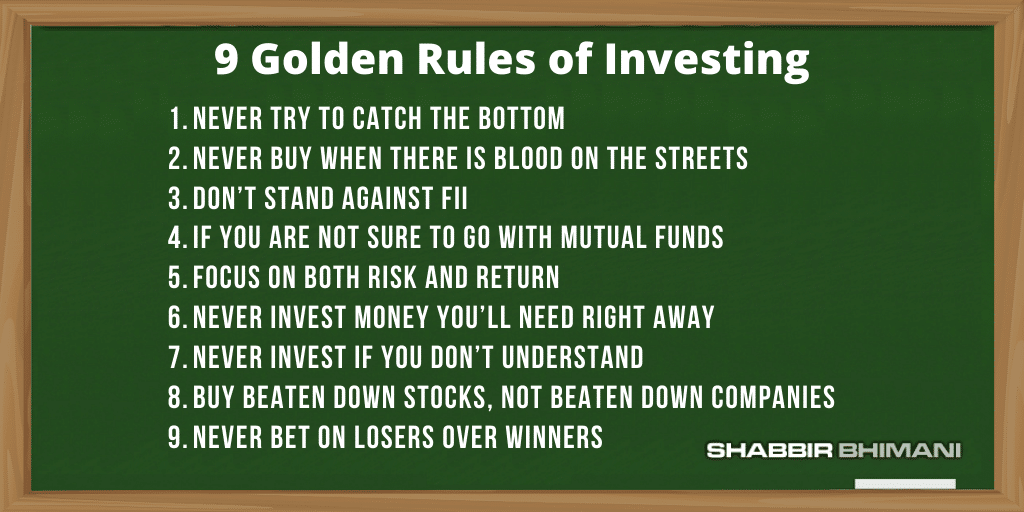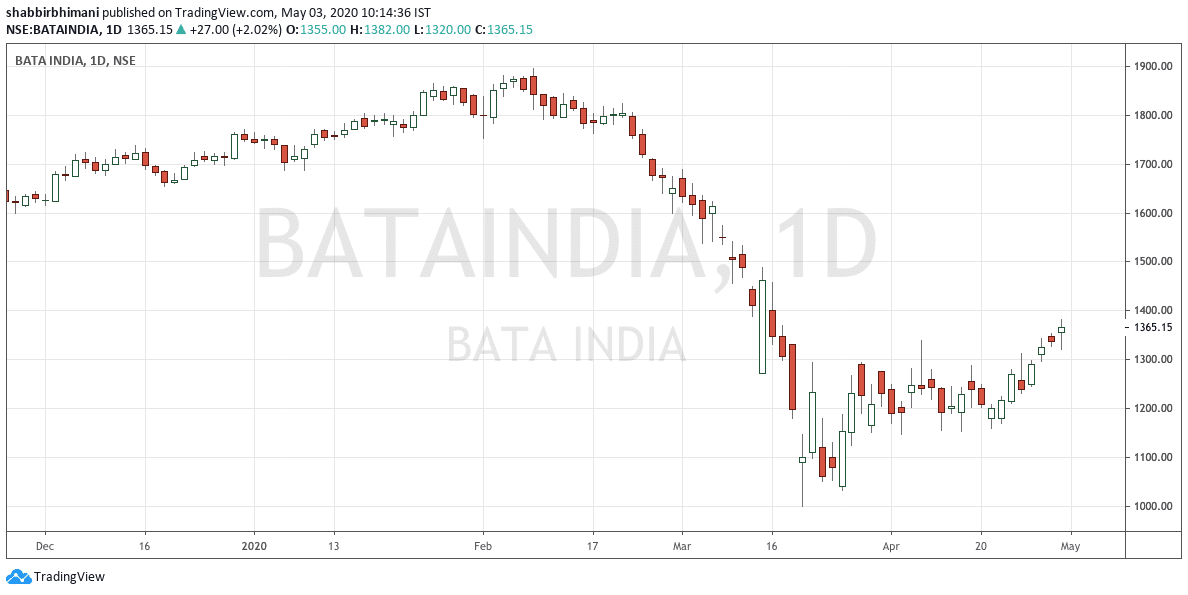The 9 Golden Rules of Investing I like to Follow When I am Investing in a Falling Market as a whole, falling sector or the falling stock
There are specific rules that one should follow when it comes to investing in the market, especially in the falling market.
Of course, these rules of investing should only apply to the right stock that passes the investment checklist and fundamental analysis.
Once the stock qualifies the above checklist and analysis, I analyze the business on very tough parameters to finally make it the right stock.
Once the stock has passed all the checks to be the right stock, then we can apply rules of Investing for the falling market.
So let me share the nine rules of investing for you.
Rule #1: Never try to Catch the Bottom
The first among the nine rules of investing is to understand the concept of the right price. People often are confused; the right price is the one that is the lowest price. However, it is not true.
Let me explain this with an example for the stock Bata India.
In the above chart, we see the stock fell almost in a straight line from ₹1900 to ₹1000. Then it consolidates in a rectangle pattern, which I have explained in detail in my book.
However, the bottom price is ₹1000, but the right price is around ₹1200 or in the range of ₹1150 to ₹1250. The other right price can be when it breaks above the consolidation range of ₹1100 to ₹1300.
Moreover, when you are investing, there can be a second wave down, and the stock may even go below ₹1000. Again, investing is not all about trying to catch the bottom. It is more about buying at a price that offers more value to you as an investor.
Rule #2: Never Buy when there is blood on the streets
The next rule among the nine rules of investing is never to assume you will miss out. Often investors (including me) make the mistake of buying the stock with an assumption they will miss out.
There is a correction in the market or even a bear phase, and it is not going to end in a hurry. You are in the market and tracking the fall.
So you may miss out on some opportunities for sure, but it won’t happen that you will miss out on every occasion that will come in the next year.
It is ok to miss some as well, but for fear of missing out, don’t try to buy when there is a continuous fall in the market.
Like we take the example of Bata India, one may be tempted to buy at ₹1300 when he has seen it was at ₹1900 a few weeks back. But when you buy when it is bleeding, seeing a price of ₹1000 means you will be tempted to book out at ₹1300 at a first instance.
Rule #3: Don’t stand Against FII
FII are sellers in the market. Let the DIIs stand against them to stabilize the market.
We, as a retail investor will come in later in the market. Make it a rule:
I will buy high and sell higher instead of buying low and sell high.
You aren’t Warren Buffett, who invests billions in a company. You want to be buying a few hundreds of shares, and one can buy at any time in a single order. For Warren Buffett, he needs a significant decline to be able to accumulate the number of shares he wants.
Rule #4: If You Are not sure to Go With Mutual Funds
The reason we are in the market is to build wealth, not invest in the stocks.
Once we are clear in our head on why we are in the market, the decision to invest becomes very simple and easy.
I Avoid Investing in Mutual Funds, but You Shouldn’t, and the reason is simple – for me, investment in stocks is a wiser choice than mutual funds because I can beat the returns I get from mutual funds by almost 10%.
So if mutual funds returns are 12%, I clock in 22% investing in stocks. Similarly, as of now, the mutual fund returns are in -5%, and my stock portfolio return is more than +5%.
So for everybody, the decision is simple. If you can beat the returns from mutual funds by a margin, it is wise to consider investing in stocks. If not, go with mutual funds.
Rule #5: Focus on Both Risk and Return
The golden rule of investing in the market is to analyze the risk and invest.
Often investors tend to focus only on one aspect, and it’s the return. They miss the vital part of the equation, which is the risk.
If you have the risk aspect of investing, you will never be able to trade on margins. It is the risk that keeps me away from futures, options, or commodities.
When you don’t focus on the risk, you won’t have a stop loss for trades or will invest without doing the homework.
Rule #6: Never Invest Money you’ll Need right away
In India, we have a misconception about the whole idea of investing in stocks.
I am sure you have heard phrases like I am a long-term investor and can hold the stock for six months.
First of all, no one can be an investor for six months. Forget about the long-term investor.
An investor is the one who invests in the business, and when you start a business, do you see results in 6 months? Never. So how can you expect the company you are investing in will begin to deliver results for you in 6 months.
So when you are investing, always invest with a few years’ view. Once you have the right perspective for the business and the team doing the company, you will generally avoid investing the money you need right away.
Rule #7: Never invest if you don’t Understand
Never invest in a company or sector which is beyond your understanding capabilities. In a recent discussion in the DIY forum, I was asked why I don’t have financials like HDFC Bank or Bajaj Finance in my portfolio.
There are multiple reasons for not having such stocks in my portfolio, but one of the critical reasons is I don’t understand the business of financing that well maybe because I don’t have a finance background.
Cash is the commodity for them. More cash means more sales. So they sell cash in the form of loans. Promoters sell stakes to bring in cash to do more business. This cycle is way beyond my understanding. What happens beyond a point when a promoter is all out.
So when I don’t understand something, it is ok to go with something that I understand.
Moreover, there are certain things that I understand very well, and it is the IT sector. Because I am B.Tech in IT and have worked in Fortune 500 and IT MNCs – I do understand their business model very well.
That makes me not to invest in them as well. I see these companies as a provider of human resources. None of the Indian IT company has a product. They only offer services.
Rule 8: Buy Beaten Down Stocks, Not Beaten Down Companies
There are three main reasons why stock comes crashing down.
- Problems which are permanent in nature
- Problems which are temporary in nature
- Everything else is falling.
I am damn sure now you understand when you should be investing in a company and when you shouldn’t be.
Punj Lloyd, Suzlon, JP Associates, or even Vodafone Idea all have a problem that is permanent in nature. No matter how much the stock falls, investors should keep themselves away from it.
Then there are stocks which fall for temporary reasons.
Pharma is one such example that had all the USFDA issues since 2015. The only question investors needed to ask – is the problem temporary or permanent? Can these companies fix the problems overtime or not?
I agree some may fix the issue in 6 months, and others may need six years. Now the investors have to do the homework of understanding the management behind the company.
Similarly, during the COVID-19 crisis, there are no sales for the automakers in April. Stocks have and will come falling.
The question investor will need to ask is – is the problem temporary or permanent? Will no sales continue forever? Can the companies survive even if there is an extended lockdown? Once things are back to normal, will India need more vehicles or less?
Rule 9: Never Bet on Losers Over Winners
The last of the nine rules of investing is to believe Mr. market is a lot more intelligent than you. No matter how well you do your homework, some stocks will be losers in your portfolio for sure. As an investor, the aim is not to get all your bets right. Focus on having more right than wrong.
So when you are focusing on being more right than wrong, some losers in the portfolio has to go away. Make sure you don’t sell the winners to average the losers. Instead, sell the losers to average the winners.
I always insist people average up over averaging down.
I call the Force Motors in my portfolio a dark horse. However, at the current price, I am not a seller because the stock is doing bad but not the business.
Looking at the current price, one can say I bought it at a very high price. Now I am not averaging it no matter what. Maybe when auto sales open up, I will reconsider what I should do based on the price and value proposition at that time.
Final Thoughts
So when you are investing in the market. Invest intelligently and use your knowledge to build wealth. You are not in the market to do what others may be doing. You can be wrong, but make sure you are solely responsible for your decisions and learn from it and don’t repeat it.





Leave a Reply